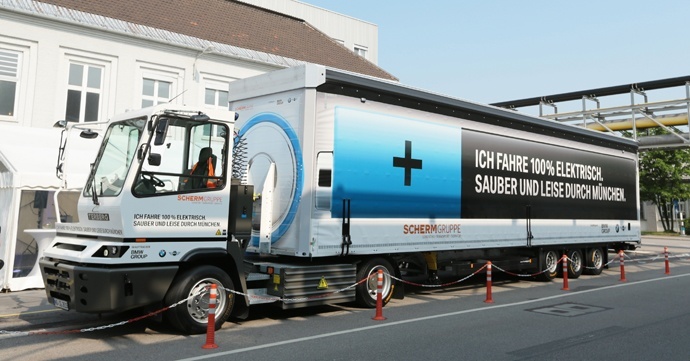There are many who say that heavy lorries are too dangerous for city roads – and increasing calls for their use to be restricted.
Quite apart form the noise and pollution they cause, over half of cyclists deaths on city roads involve a heavy goods vehicle. If they didn’t already exist, it’s questionable whether lorries weighing forty tons would be permitted on city streets – if only on grounds of health and safety. In light of this road danger, BMW have made the best of a bad lot by introducing an entirely electric HGV that also boasts a cab with excellent driver visibility.
BMW electric HGV

The 40-ton electric truck now drives between the logistics company SCHERM and the BMW plant in Munich eight times a day. BMW is the first car maker in Germany to use an electric truck of this size to transport materials on public roads.
Thanks to its alternative drive train, the truck is quiet, emissions-free in traffic and generates virtually no particle pollution for the environment. The electric HGV produces 11.8 tons less CO2 per year than an equivalent diesel-powered lorry.
Can any HGV be safe for cyclists?
At the moment, the answer unfortunately is no. The best single piece of advice for cyclists in towns and cities is to be hyper aware of lorries at junctions and give them a wide berth whenever possible. It’s an example of the defensive riding that can help keep you safe, but why should the onus so often be on vulnerable road users?
Until we have the high quality infrastructure, road policing and legal framework to transform streets into places designed for people rather than motorised traffic, there must at the very least be mandatory safety equipment standards for the Heavy Goods Vehicles (HGVs) that operate on our roads to benefit cyclists and pedestrians. British law currently requires most HGVs to be fitted with side guards and extended view mirrors. However, certain HGVs, including construction vehicles are exempt from national regulations requiring side guards. Older HGVs are exempt from national regulations requiring mirrors.
“In more than 60 per cent of European cities, HGV movements are restricted”
Speaking to the Telegraph two years ago, Chris Boardman – a man who always talks a lot of sense about cycling – said of a conversation with Boris Johnson:
“I am really disappointed that we had a conversation eight months ago and he said we will look into HGVS. Nothing has happened.”
“I think their use in cities needs to be managed. In more than 60 per cent of European cities, HGV movements are restricted. In Paris, for example, there are no articulated vehicles in the centre of the city and there were zero cycling deaths last year. There is huge evidence in favour of it. These things are not happy bedfellows for cyclists. They should be restricted and it can be done. All those cities across Europe that have done it seem to be working fine. The Mayor told me he would look into it. I don’t know whether he has, but I certainly can’t see any action.”
Over a dozen cyclists in London have been killed by lorries since the announcement that almost £1 bn was to be spent on a cycling revolution for the city. The BMW electric HGV, while clever, can wait – a ban on HGVs during rush hour would be a good start towards stopping these entirely preventable tragedies.
Cycle insurance
On the face of it, one cycle insurance policy is much like another, but the devil is the detail. How much excess you will be charged is just one of the things that varies wildly between providers. Another is so called ‘new-for-old’ replacement – many insurers use this term, but if your bicycle is more than a few years old, devalue it severely. This means you are left out of pocket when you come to replace it.
ETA cycle insurance has a low standard excess of 5% (minimum £25) and offers a new-for-old for life – how ever old the bike, if it’s stolen you get enough to buy a new model.
 For 25 years we have been providing straightforward, affordable bicycle insurance. Whether you use your bike to commute, shop, race or amble in the park, ETA Cycle Insurance has you covered. We never devalues bikes no matter their age, allow you to buy your replacement bike wherever you like, replace stolen quick release components and we handle claims in-house. Can your insurance provider say the same?
For 25 years we have been providing straightforward, affordable bicycle insurance. Whether you use your bike to commute, shop, race or amble in the park, ETA Cycle Insurance has you covered. We never devalues bikes no matter their age, allow you to buy your replacement bike wherever you like, replace stolen quick release components and we handle claims in-house. Can your insurance provider say the same?
Furthermore, every cycle insurance policy you buy helps support the work of the ETA Trust, our charity campaigning for a cleaner, safer transport future.
edmund white
One simple way would be to do as was done 30-40 years ago, put the most of the freight back on the rail network. This would solve two problems in one, Railways would make more money ( so needing less subsides) and you would only need smaller trucks running from hubs to do local drops. One freight train= 30 or more HGVs.
End result few or no HGVs, less danger to all road users, also less pollution & wear on the roads. A rail system making money, maybe even enough to sort out the passenger side of rail travel and cut fares. Maybe that’s the problem, it would need the powers that be to admit they got it wrong, and that would never do.